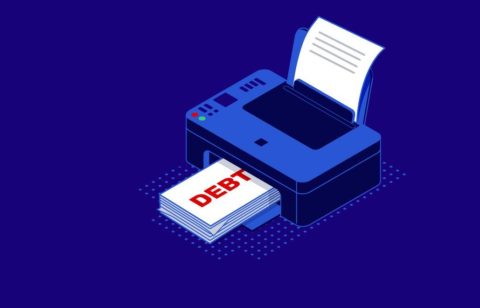It’s currently estimated that outstanding US student loan debt exceeds $1 trillion. Assuming this is true it would make student loan debt an even bigger issue than credit card debt. And depending on which source you believe this past June’s graduates owed an average of either $24,000 or $33,000 in student debt.
How did we get to this place?
Some people believe the problem began way back in the Reagan administration when Congress shifted funding from student aid to student loans. While this may be true it’s equally true that the cost of a college education has skyrocketed over the past 20 years. In fact, the cost of going to college has been increasing at about a 7% rate per year for decades. The overall consumer price index has risen 115% since 1985 while the college education inflation rate has grown nearly 500%. What this translates into is if college tuition cost $10,000 in 1986 and its cost had increased at the same rate as inflation, it would now cost $21,500. However, the average is now $59,800 or more than 2 1/2 times the rate of inflation. Given this, it’s fairly easy to see why most people end up having to get student loans to pay for their educations.
Is it worth it?
Is a college education really worth paying $59,800 or more just for your tuition? The answer to that is a simple “maybe” because it will depend largely on your field of study. If you choose a STEM major (Science, Technology, Engineering, Mathematics) then borrowing money to help pay for your education will definitely be worth it. On the other hand, if your passion is preschool education, anthropology, archaeology, philosophy or fine arts then getting loans to finance your education may not pay off.
How to determine how much is too much
If you are in college there is a way to determine how much is too much. First, you will need to determine two things — how much your starting salary will be in your intended field and how much debt you will have when you graduate. If your total debt is less than your annual starting salary, you should be able to pay back your student loans comfortably in 10 years or less – if this is what you plan on doing.
Use a student loan calculator
Once you determine how much money you will need to finance your schooling, you could use a student loan calculator to determine what your payments will be. When you match them against your starting salary you should have an even better idea of how much is too much.
The gift that keeps on taking
Student loan debt is the opposite of the gift that keeps on giving as it keeps on taking. If when you graduate you are on the Standard Repayment program it will take you 10 years to repay your loans. This could force you to delay some of the most important things of life such as getting married, buying a house or having kids. While you could move to another repayment program such as Extended Repayment to get your monthly payments reduced, this could keep you in debt for as long as 25 years. You could still be repaying your student loan debts when your children are worrying about paying for their educations.
How to keep college debt under control
If you’re still in school there are some things you can do to keep your college debt from getting out of control. You should make sure you apply for scholarships through sites such as Scholarships.com and Fastweb.com and through your college or university. Second be sure to fill out your FAFSA as you might qualify for grants. If one of your parents belongs to a club or organization or if you are the member of a church, see if it offers scholarships or grants. Third, when you borrow money be sure to get federal student loans and not private student loans as private ones tend to have higher interest rates and are subject to change. Finally, pay as much out-of-pocket towards your college costs as you can by working part-time or try to graduate faster, which will mean fewer semester fees.
If you’ve already graduated
In the event you’ve already graduated and owe a ton of student debt the one thing you don’t want to do is default on your federal loans. The government actually has more power to come after you then does even the most aggressive debt collector. It can garnish your wages, take part of your income tax refunds or seize 15% of your Social Security payments. You can’t even get out from under student debt by filing for bankruptcy.
Don’t hold your breath
Believe it or not you can’t even refinance federal student loans. However, there have been several attempts made to change this. In the Senate, Elizabeth Warren introduced a bill that would make it possible for people to refinance their student loans at better interest rates and Rep. Mark Pocan did the same thing in the House. While these bills stalled in committee, both Warren and Pocan have said they will bring them up again in the next session of Congress.
Stop waiting for a good fairy
If you have student loans at 5% or 6% and could refinance them down to 2% or 3% this would certainly help with your monthly payments. But what many people are experiencing is buyers’ remorse. They wish they had never borrowed the money and what they really want is for a fairy to swoop down and forgive all their student debts. News swept the Internet a few months ago that Pres. Obama was going to issue an order forgiving all federal student loan debts. This, of course, was a false rumor. Pres. Obama really doesn’t have the authority to do thie and even if he did, it would likely send our economy into a tailspin.
 Buckle down and repay them
Buckle down and repay them
At least at this point the best answer to federal student loan debts is to buckle down and repay them. If you’re on the 10-Year Standard Repayment program and are having a tough time making your monthly payments, you could switch to another repayment program. One of the most popular of these is Graduated Repayment where your payments start low but then gradually increase every two years. This can be an excellent option if you’re just starting out in your career. There are also three different types of income-driven repayment programs where your monthly payments would be based on your income. If you were to qualify for one of them – Pay As You Earn – your monthly payments would be capped at just 10% of your discretionary income and you could earn forgiveness after 10 years.
Check out your options
What this means is that you need to check out your other options to see if there isn’t another repayment program that would be better for you given your circumstances. The government site https://studentaid.ed.gov/ has good information about the various repayment programs and how to know if you would be eligible for one or more of them.





